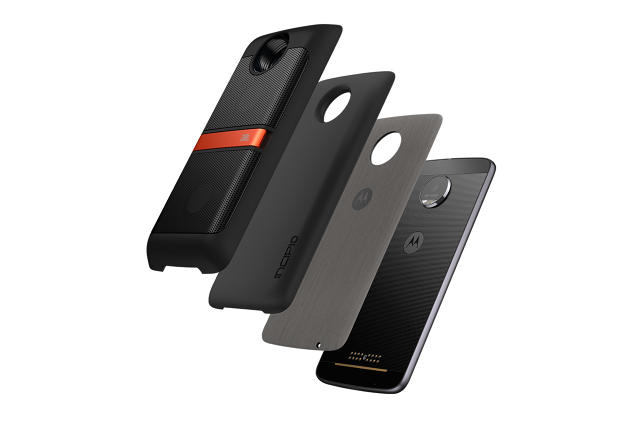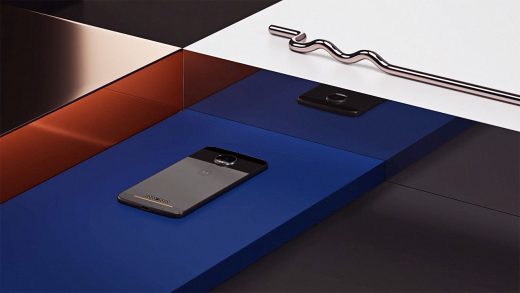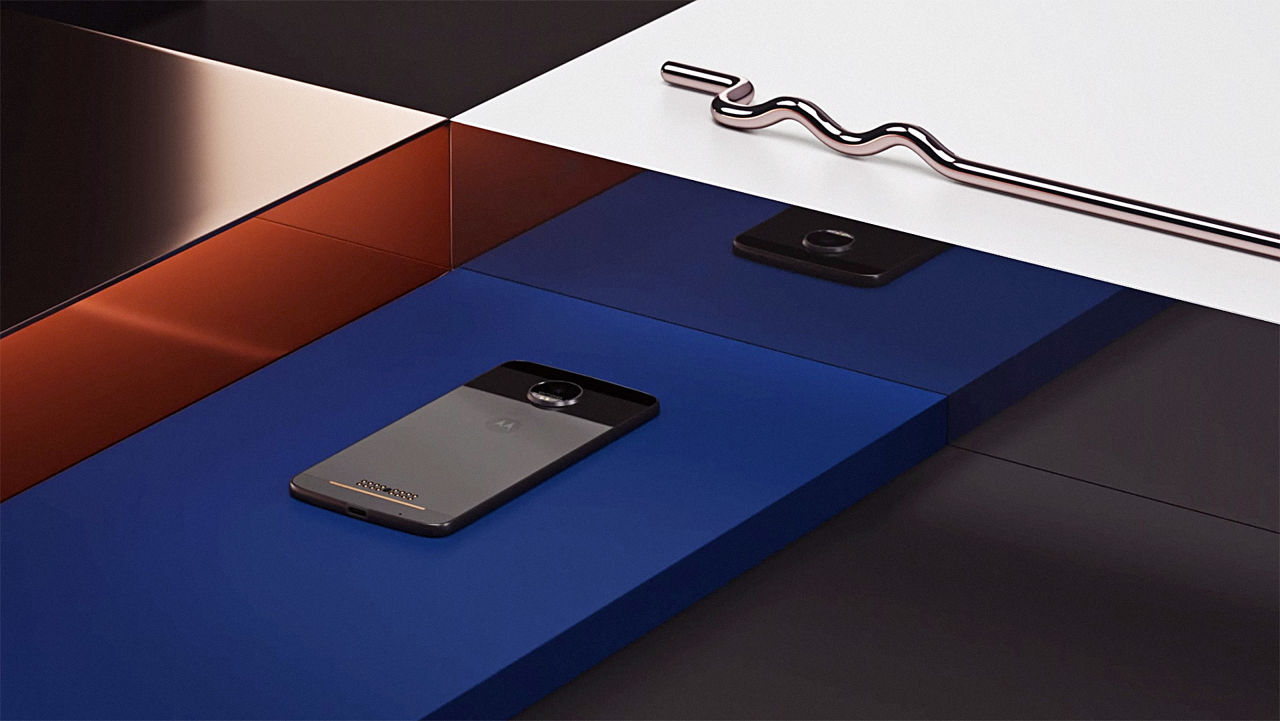The Moto Z Phone’s Moto Mods Are A Cool Concept That Need Time To Grow
On their own, Lenovo’s two Moto Z smartphones aren’t that remarkable.
Both models have slick designs, capable cameras, fast processors, and fingerprint readers. What they don’t have is a killer hook to make people buy them over the Samsung and Apple phones that dominate the high-end market. Sure, the Moto Z claims to be the world’s thinnest premium phone, but that advantage is sure to be fleeting, and may have necessitated the removal of a headphone jack. The Moto Z Force’s shatter-proof plastic display is unique, but its other main draw, a jumbo-sized battery, has been matched by other phones such as Samsung’s Galaxy S7 Edge.
But if you’re willing to spend a little more, the Moto Z ($624) and Moto Z Force ($730) have one neat trick: You can attach a variety of back covers, called Moto Mods, that extend the phones’ functionality. This allows Lenovo to support features that would be impractical if built into the phone itself, such as half-decent speakers, a projector, or an even larger battery.
After a couple weeks with Verizon’s “Droid Edition” versions of the Moto Z and Moto Z Force (unlocked versions are coming for AT&T and T-Mobile in September), I’m rooting for the Mod concept to succeed. But for that to happen, Lenovo will need a level of persistence not commonly seen among Android phone makers.
Moto Mods In Action
Each Moto Mod connects magnetically to the rear panel of the Moto Z, with an opening that fits snugly around the phone’s protruding camera lens. A set of pins on the bottom of each panel transfers data and power, with a notification on the phone confirming a successful connection. The magnets are strong enough to keep the Mods from coming apart with mere shaking and prodding; each panel has a small gap at the bottom for prying away with a fingernail.
At launch, Lenovo is offering three Moto Mods as optional purchases.
The JBL SoundBoost Speaker ($80) is a stereo speaker with a built-in kickstand. The audio quality hovers somewhere between typically awful smartphone speakers and dedicated Bluetooth ones, with a noticeable lack of bass response and depth. It’s also pretty chunky, thanks to the 10-hour battery that’s built in. You probably wouldn’t use it for your next party, but it’s helpful for private listening sessions, speakerphone calls, and watching videos. (One other nitpick: There are no equalizer settings on the hardware or its companion software.)
Moto’s Insta-Share Projector ($300) is a pico projector that can beam an image up to 70 inches. It also has a built-in stand—useful for projecting onto a ceiling instead of the wall—and intelligent keystoning for off-angle projections. But it’s not a very bright projector, and the built-in battery only lasts for about an hour. It also produces a noticeable whirring sound during use. Still, with ceiling projection in a dark room, it’s better than a TV for watching Netflix before bed.
Finally, there’s the Offgrid Power Pack ($60) from Incipio, a 2,220 mAh battery that adds up to 22 hours of extra usage and supports wireless charging. It’s the least flashy of all the Moto Mods, but also the most practical for day-to-day use, if you can forgive one significant flaw: The battery itself lacks its own charging port, and you can only recharge it while it’s connected to the phone. That means you can’t top up the external battery at home while you’re out and about with your phone. (The other two Mods have their own USB-C ports, so you can charge them independently of the phone.)
When you’re not using any of these mods, you can leave the back panel and its gold connector pins exposed for a sci-fi design vibe, or attach a “Style Shell” with materials like wood grain, leather, and fabric. The shells are a nod to the Moto Maker program of previous Lenovo phones, which lets users customize their phones’ rear panels, buttons, and speaker grilles.
Overall, the first wave of Moto Mods are unique, if not essential. I found myself reaching for the battery more often than not, as the speaker and projector Mods only make sense in special circumstances and weren’t worth the added bulk most of the time.

Sticking To It
More intriguing than the initial Moto Mods is the possibility that the line may expand over time. Alongside its own Mods, Lenovo is offering a Moto Mods Development Kit, which should allow anyone—from individual hackers to other companies—to build their own attachments.
It’s easy to dream of what shapes future Mods might take. Lenovo’s own developer samples include a temperature sensor and controls for a secondary display (in E-Ink, perhaps?). There is talk that Hasselblad is working on a camera attachment. I’d love to see a powered magnetic car mount, a flip-out physical keyboard, or a even MIDI keyboard for musicians. Perhaps there’s even room for lower-cost, non-powered attachments, such as wallet cases or simple kickstands.
But before Mods can flourish, Lenovo will need to show that it’s invested in the concept over the long haul. That rarely happens in the Android world, where phone makers love to test out unique ideas only to abandon them shortly thereafter.
Some examples:
- Motorola’s Atrix phone, released in 2011, had an optional laptop dock for running a web browser and smartphone apps. After vowing to expand on the concept with new hardware, Motorola scrapped those efforts in 2012.
- In 2014, HTC released the One (M8), with a dual-lens camera that could change focus after the shot was taken. The company even promised an SDK to bring the focus features to third-party apps. But instead of building on this feature, HTC abandoned it after a single attempt. (An iPhone with dual lenses is rumored for this year or next.)
- Samsung’s Note Edge, released in 2014, offered a persistent multitasking menu on the curved portion of its display, and allowed app developers to create menus of their own. Those features were scrapped with 2015’s Galaxy S6 Edge, whose curved portions are limited to informational widgets.
- Asus’ Padfone series of smartphones were able to dock into a tablet-sized display. But these were just a series of isolated products, rather than an ecosystem of dockable displays. Asus never really fleshed out the concept, and hasn’t released a new version in two years.
- In 2011, Kyocera developed a dual-screen smartphone called the Echo, and even offered a development kit for app makers who wanted to optimize their software. But app support never really came, and Kyocera never attempted a dual-screen phone again.
Granted, not all of these products worked well or seemed like great ideas at the time, but that’s the point: Sometimes it takes a few tries to refine an idea into a winning product. Too often, Android device makers lack the conviction to stick with it.
Fortunately, there are signs that Lenovo is taking Mods more seriously.
The company says it will support the current crop of Moto Mods for another two hardware cycles, including new phones in 2017 and 2018. That’s a significant bet on the concept, considering that each Mod must adhere to a particular size, shape, and camera cutout. Lenovo is also pledging $1 million in equity funding through its Capital and Incubator Group to the person or company that makes the best Mods prototype within the next nine months.

By contrast, LG, which also introduced a mod concept in its latest G5 smartphone, won’t make any commitments to future smartphone generations. And while the company has launched a developer program, it hasn’t announced any financial incentives, and LG is mandating that it approve and co-develop all hardware.
Lenovo seems much more committed to the long haul, but one could still imagine a scenario where the company de-emphasizes the whole concept. If the Mods don’t sell, maybe that initial funding contest becomes the one and only, developer kits stop being produced, Lenovo suspends building new Mods of its own, and the initiative ends up fading away.
In that case, Lenovo would be back to selling phones that are less remarkable—but a lot less risky as well.
Fast Company , Read Full Story
(30)












